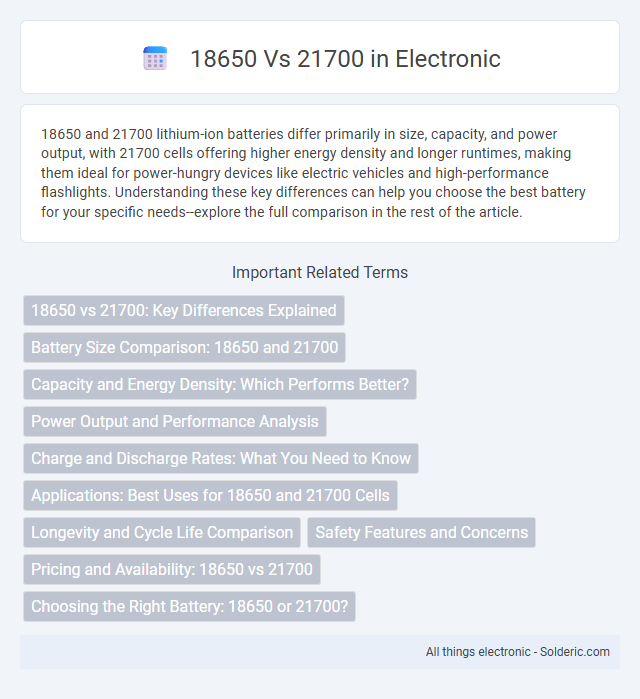18650 and 21700 lithium-ion batteries differ primarily in size, capacity, and power output, with 21700 cells offering higher energy density and longer runtimes, making them ideal for power-hungry devices like electric vehicles and high-performance flashlights. Understanding these key differences can help you choose the best battery for your specific needs--explore the full comparison in the rest of the article.
Comparison Table
| Feature | 18650 | 21700 |
|---|---|---|
| Dimensions (mm) | 18 x 65 | 21 x 70 |
| Capacity (mAh) | 1800 - 3500 | 3000 - 5000 |
| Voltage (Nominal) | 3.6 - 3.7 V | 3.6 - 3.7 V |
| Max Continuous Discharge (A) | 10 - 30 | 15 - 35 |
| Energy Density | Lower | Higher |
| Weight (g) | 40 - 50 | 60 - 70 |
| Common Applications | Laptops, Flashlights, E-cigarettes | Electric Vehicles, High-performance Power tools |
18650 vs 21700: Key Differences Explained
18650 and 21700 lithium-ion batteries differ primarily in size, capacity, and energy density, with 21700 cells typically measuring 21mm in diameter and 70mm in length compared to the 18mm by 65mm dimensions of 18650 cells. The larger 21700 batteries offer increased capacity, often ranging from 4000mAh to 5000mAh, surpassing the usual 18650 capacity of 2500mAh to 3500mAh, which translates into longer device run times and higher power output. Manufacturers favor 21700 cells in high-demand applications such as electric vehicles and power tools, while 18650 batteries remain popular in laptops, flashlights, and smaller electronic devices due to their established compatibility and availability.
Battery Size Comparison: 18650 and 21700
The 18650 battery measures 18mm in diameter and 65mm in length, while the 21700 battery is larger, measuring 21mm in diameter and 70mm in length. This size difference allows the 21700 cells to offer higher capacity and improved energy density compared to the more compact 18650 cells. When selecting a battery, your device's space constraints and power requirements will determine whether the 18650 or 21700 is the most suitable option.
Capacity and Energy Density: Which Performs Better?
21700 batteries generally offer higher capacity and energy density compared to 18650 cells, providing up to 5000mAh versus 3500mAh typically found in 18650s. This increased capacity translates to longer-lasting power for devices such as electric vehicles and high-drain gadgets. Your choice will depend on the balance between size constraints and the need for extended runtime, with 21700 cells leading in performance efficiency.
Power Output and Performance Analysis
The 21700 battery typically delivers higher power output and better performance compared to the 18650 due to its larger size and increased capacity, which allows for greater energy storage and higher continuous discharge rates. In high-drain devices like electric vehicles and power tools, 21700 cells provide improved efficiency and longer runtime, enhancing overall device functionality. While 18650 cells remain popular for their compactness and versatility, 21700 batteries dominate applications requiring superior power density and sustained performance.
Charge and Discharge Rates: What You Need to Know
18650 and 21700 lithium-ion batteries differ significantly in charge and discharge rates, with 21700 cells typically offering higher capacity and current output, making them ideal for high-drain applications. The 18650 battery generally supports a charge rate of around 0.5C to 1C and a continuous discharge rate between 10A to 20A, while 21700 batteries can handle charge rates up to 1C and discharge rates exceeding 20A due to their larger size and improved thermal management. Understanding these specifications helps optimize battery performance, safety, and longevity in devices like electric vehicles and power tools.
Applications: Best Uses for 18650 and 21700 Cells
18650 cells are ideal for compact devices like laptops, flashlights, and vape mods due to their smaller size and reliable performance. 21700 cells offer higher capacity and better energy density, making them perfect for electric vehicles, power tools, and high-drain devices requiring longer runtimes. Choosing the right battery depends on your application's space constraints and power demands.
Longevity and Cycle Life Comparison
18650 and 21700 lithium-ion batteries differ notably in longevity and cycle life, with 21700 cells typically offering higher cycle counts due to their larger capacity and improved thermal management. 21700 batteries often provide up to 500-600 full charge-discharge cycles, surpassing the 300-500 cycles commonly achieved by 18650 cells. Choosing 21700 batteries can extend Your device's lifespan by reducing the frequency of replacements and maintaining consistent performance over time.
Safety Features and Concerns
18650 and 21700 batteries differ significantly in safety features and concerns; 21700 cells generally offer higher capacity and improved thermal management due to their larger size, reducing overheating risks. Both types require proper handling, protection circuits, and quality assurance to prevent hazards like short circuits, but 21700 batteries often incorporate advanced safety mechanisms such as reinforced separators and enhanced venting systems. Your choice should consider these safety aspects alongside device compatibility to ensure optimal performance and protection.
Pricing and Availability: 18650 vs 21700
18650 batteries remain more affordable and widely available due to their long-standing use in various devices, making them a cost-effective choice for many applications. 21700 batteries, while generally pricier, offer higher capacity and performance, leading to increased demand and expanding availability in recent years. Your decision may hinge on budget constraints and whether the enhanced power and lifespan of 21700 cells justify the additional cost.
Choosing the Right Battery: 18650 or 21700?
When choosing the right battery for your device, consider that 21700 batteries offer higher capacity and longer runtimes compared to 18650 cells, making them ideal for high-performance applications. However, 18650 batteries are more compact and widely available, providing versatility for smaller devices and cost-effectiveness. Your decision should balance power needs, size constraints, and budget to select the optimal battery type.
18650 vs 21700 Infographic

 solderic.com
solderic.com